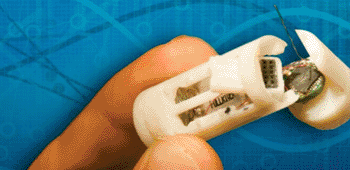Special-Purpose Capsule Restores Surgeons’ Tactile Sense
By HospiMedica International staff writers
Posted on 14 Nov 2013
A small, wireless capsule helps restore the sense of touch that surgeons are losing as they shift increasingly from open to minimally invasive surgery (MIS).Posted on 14 Nov 2013
A team of engineers and doctors at Vanderbilt University (Nashville, TN, USA) designed a wireless palpation probe (WPP) equipped with a pressure sensor that fits through ports used in laparoscopic surgery. Deployed through a trocar incision and directly controlled by the surgeon, the WPP is pressed against the target tissue. The data from the sensor is used to create a volumetric stiffness distribution map, which can then be used to guide tissue resection to minimize healthy tissue loss. The map can reveal the location of tumors, arteries, and other important structures that the cameras cannot see because they are covered by a layer of healthy tissue.

Image: The interior structure of the WPP capsule (Photo courtesy of Vanderbilt University).
The palpation capsule, which is just 1.5 cm wide and 6 cm long, contains a pressure sensor, an accelerometer, a wireless transmitter, a magnetic field sensor, and a small battery. The pressure sensor records how hard the end of the capsule is being pushed against its target; the accelerometer records its movements. The WPP is used with a fixed external magnet and its position is tracked precisely by measuring the strength and direction of the magnetic field it experiences. The wireless transmitter sends all this information to an external antenna connected to a computer that uses the data to draw the map of tissue stiffness.
In desktop testing with tissue simulated by silicone gel, the researchers reported that the capsule can measure the local stiffness of the tissue with a relative error less than 5%; in large animal tests, they achieved a relative error of 8%. The ultimate goal is to achieve a level of resolution comparable to or greater than that of human touch. One possibility suggested is using the WPP data with a commercially available “haptic glove” that would allow the surgeon to feel pressure that the capsule is exerting and how the tissue is responding almost as if they are touching it directly. The system is described in an article published on August 21, 2013, in the journal IEEE Transactions on Biomedical Engineering.
“Because palpation is so important to surgeons, there have been several previous attempts to build instruments that can provide it,” said lead author Pietro Valdastri, PhD, an assistant professor of mechanical engineering and medicine. “Our approach is much simpler because it isn’t attached to a rigid shaft like previous tools and so does not force the surgeon to make an additional incision in the patient to use it.”
“The hope behind something like this capsule is that the surgeon will be able to place it inside the body through an existing incision and leave it in a position where it can be easily grasped and used to map out the stiffness or density of the tissue when needed, much like he or she would palpate it with by hand in open surgery,” said coauthor S. Duke Herrell, MD, an associate professor of urologic surgery at Vanderbilt University School of Medicine.
Related Links:
Vanderbilt University














